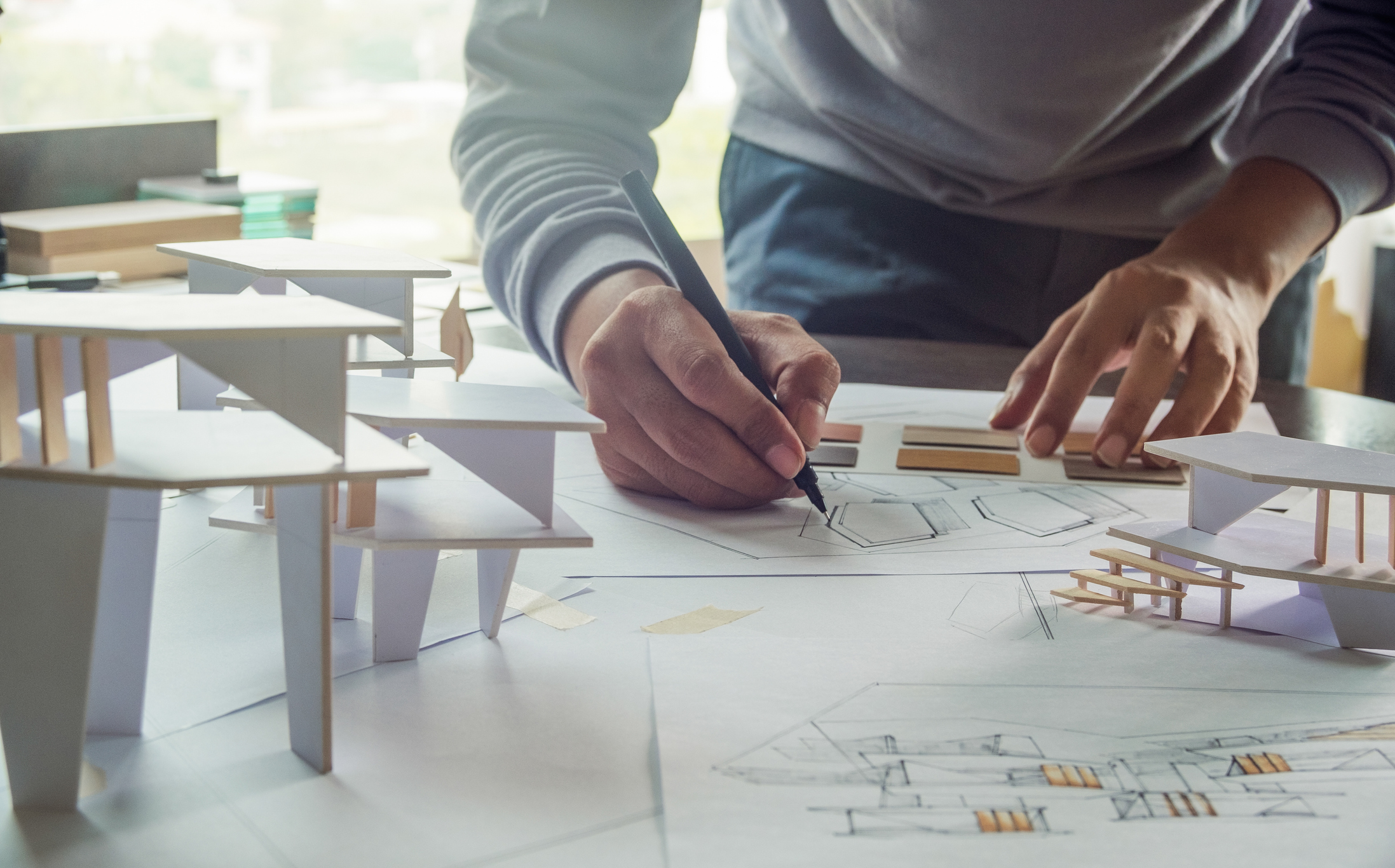Architect Collaboration Tips for Working with Engineers and Builders
Architect Collaboration Tips for Working with Engineers and Builders
Blog Article
Comprehending the Diverse Job Paths Available for Aspiring Architect
As an ambitious Architect, you have a globe of career courses waiting on you. Each path provides one-of-a-kind difficulties and possibilities to apply your creativity and technical knowledge. Whether you're drawn to conventional design or the subtleties of lasting layout, there's a particular niche that aligns with your rate of interests. Comprehending these varied options can shape your professional trip, however which instructions will you select to check out first?
Typical Architecture: Designing Structures and Structures
Typical architecture focuses on designing buildings and frameworks that mix functionality with visual charm. As you explore this field, you'll appreciate the intricate balance between form and objective. You'll learn to attract inspiration from historical designs, integrating components like balance, materials, and craftsmanship. Your styles can mirror social heritage, showcasing regional customs while meeting modern demands.
You'll develop skills in composing, model-making, and website analysis, permitting you to envision and communicate your concepts successfully. Engaging with customers, you'll need to recognize their vision and equate it right into practical styles.
Additionally, constructing codes and sustainability techniques are important in your job, guaranteeing your frameworks are safe and ecologically friendly. As you grow in your career, you'll discover opportunities in residential, business, and even reconstruction jobs, each offering distinct difficulties. Accepting typical style leads the way for a fulfilling job that pays homage to the past while forming the future.
Urban Planning: Shaping Neighborhoods and Public Spaces
As an ambitious Architect, you can play a vital role as a city organizer, transforming just how areas function and interact. By using neighborhood interaction approaches, you'll assure that locals have a voice fit their atmosphere. Plus, incorporating sustainable layout concepts will certainly assist develop areas that not only fulfill today's demands but likewise safeguard the future.
Role of Urban Planners
While lots of could assume of architects as the sole dreamers behind structures, metropolitan coordinators play an important function in shaping the more comprehensive landscape of neighborhoods and public spaces. By teaming up with different stakeholders, you'll assist develop parks, transport systems, and domestic areas that promote social communication and accessibility. Your know-how in spatial layout and neighborhood dynamics permits you to envision future development while protecting cultural heritage.
Area Interaction Approaches
Effective community interaction techniques are essential for urban organizers to assure that the voices of locals are listened to and valued in the preparation procedure. To promote purposeful dialogue, you ought to prioritize open discussion forums and workshops where neighborhood members can reveal their concepts and problems. Use surveys and social media sites to reach a more comprehensive audience, guaranteeing diverse viewpoints are included. Working together with regional organizations can improve trust and promote much deeper links. It is necessary to provide clear information regarding decision-making procedures and proposed tasks, enabling locals to feel enlightened and equipped. By actively listening and integrating responses, you'll develop rooms that show the neighborhood's needs, ultimately leading to even more lasting and effective metropolitan atmospheres. Accept openness and continuous discussion for enduring influence.
Lasting Design Concepts
When creating city spaces, incorporating lasting layout concepts is important for producing atmospheres that prosper both environmentally and socially. You ought to start by focusing on power effectiveness, using materials that reduce waste and promote recycling. Think about integrating eco-friendly spaces, like yards and parks, to improve biodiversity and boost air high quality. Advertising walkability and public transport can lessen reliance on vehicles, cultivating a healthier area.
Designing with water preservation in mind is additionally key-- consider rain yards and permeable surfaces to take care of stormwater. Entailing area members during the planning process guarantees that the spaces you produce satisfy their demands and urge social interaction. By accepting these concepts, you'll add to dynamic, lasting metropolitan landscapes that profit everybody.

Landscape Design: Producing Lasting Outside Atmospheres
As you check out landscape design, you'll discover crucial layout principles that develop beautiful and practical exterior areas. Sustainable practices play an essential duty in making certain these settings thrive while reducing ecological effect. Plus, you'll discover a selection of career possibilities that permit you to make a genuine distinction in how individuals communicate with nature.
Design Concepts in Landscape
Understanding design principles in landscape style is important for developing lasting outdoor environments that integrate with nature. You'll need to contemplate components like range, proportion, and balance to assure your layouts feel natural and inviting. Integrating indigenous plants not only improves biodiversity but also minimizes water usage, making your landscape durable. Think concerning the flow of space and how individuals engage with it; pathways and seating areas need to welcome expedition and relaxation. In addition, take notice of seasonal changes, designing with materials that enhance the environments year-round (Architect). By focusing on sustainability and aesthetics, you can create exterior areas that improve the neighborhood and promote well-being. Embracing these principles will establish a strong foundation for your job in landscape style.
Sustainable Practices Review
Sustainable methods in landscape style not only concentrate on appearances however additionally prioritize eco-friendly wellness and source conservation. By integrating indigenous plants, you improve biodiversity and minimize the need for chemical fertilizers and chemicals. Implementing reliable irrigation systems assists conserve water and reduces runoff, shielding close-by environments. You can make areas that advertise dirt health, such as making use of natural materials and exercising permaculture principles. Additionally, incorporating eco-friendly facilities, like rain yards and porous pavements, aids in stormwater monitoring and minimizes urban warmth. You add to a healthier world and give areas that promote neighborhood link when you produce exterior environments with sustainability in mind. Eventually, these practices ensure your layouts profit both individuals and the atmosphere for many years ahead.
Profession Opportunities Exploration
With a strong foundation in lasting practices, landscape style provides a range of career courses that enable you to make a purposeful influence on the environment. You can work as a landscape designer, creating cosmetically pleasing and functional outside areas, or concentrate on eco-friendly repair, assisting to revive broken communities. Urban coordinators frequently team up with landscape engineers to produce eco-friendly areas in metropolitan setups, boosting city livability. If you're enthusiastic about education and learning, take into consideration becoming a landscape design educator, motivating future generations. In addition, you may deal with nonprofits concentrated on ecological sustainability or participate in study to innovate new practices. Each path not just forms beautiful atmospheres but likewise cultivates a healthier earth for future generations.
Sustainable Layout: Focusing on Eco-Friendly Practices
As you explore your profession in design, embracing green techniques can set you apart in a competitive field. Lasting design concentrates on producing structures that minimize environmental influence while improving occupant wellness. By incorporating eco-friendly materials, energy-efficient systems, and lasting he said building techniques, you'll add to a greener future.
Begin by gaining knowledge of eco-friendly accreditations like LEED or BREEAM, which can boost your credentials. Take into consideration how all-natural light, ventilation, and thermal performance can enhance style. Work together with engineers and environmental experts to innovate services that reduce waste and conserve sources.
Do not neglect the relevance of neighborhood involvement-- appealing neighborhood stakeholders can inspire layouts that balance with the atmosphere. As clients significantly prioritize sustainability, your proficiency in green methods will certainly not just bring in projects yet likewise meet your interest for responsible architecture. Accept this essential element of the career, and view your profession grow.
Historical Preservation: Safeguarding and Restoring Cultural Heritage
While you start on your architectural trip, take into consideration the essential function of historical conservation in keeping our cultural heritage. This field concentrates on the security and reconstruction of significant structures, websites, and structures that inform the tales of our past. By involving in historical conservation, you'll help protect the architectural tradition that forms neighborhood identity.
As a historic preservation Architect, you'll assess historical importance and assess the condition of structures. You'll work carefully with chroniclers and conservationists to assure genuine repair techniques are employed. This job course enables you to blend creative thinking with research, allowing you to design options that respect original materials and craftsmanship.
Your job not only adds to sustainability by reusing existing structures however likewise promotes a feeling of satisfaction within areas. Welcoming this course will help you end up being a guardian of background, preserving the stories and aesthetics that enhance our lives.
Inside Architecture: Enhancing Indoor Spaces
Historical preservation and interior style both share a commitment to boosting the constructed environment, yet they Source focus on different aspects. While historical preservation stresses maintaining a structure's social and historical value, interior design nos in on optimizing interior rooms for performance and appearances.
As an aspiring Architect, you'll locate that indoor design permits you to mix creativity with technical skills. You'll develop spaces that not only look excellent but additionally advertise convenience and performance. This area entails recognizing just how light, shade, and products connect within a room, influencing state of mind and functionality.
You'll service different jobs, from domestic homes to industrial offices, guaranteeing that each environment meets the needs of its occupants. By focusing on customer experience, you can transform interiors into practical and inspiring spaces, making a significant influence on how people engage with their surroundings. Embrace the possibility to improve indoor environments and form the method people live and function.
Industrial Design: Combining Capability With Appearances
Industrial design plays an important duty in producing products that seamlessly mix aesthetic appeals with functionality, making certain that what you make use of daily is not only aesthetically appealing yet likewise practical. As a hopeful Architect, you can immerse on your own in this field, concentrating on developing every little thing from furniture to customer electronic devices. Your work involves understanding customer requirements, products, and manufacturing procedures, allowing you to produce innovative options that enhance daily experiences.
In industrial design, you'll frequently collaborate with marketing experts, designers, and suppliers, making sure that your designs are not just gorgeous but additionally viable. This occupation path offers a vibrant atmosphere where imagination meets usefulness, making it a satisfying option for engineers interested in shaping the items of tomorrow.
Often Asked Concerns
What Educational Qualifications Do I Need to Become an Engineer?
To end up being an architect, you'll require a professional level in architecture, normally a Bachelor's or Master's. Furthermore, you'll need to complete a teaching fellowship and pass the Architect Registration Assessment to practice legitimately.
Exist Certification Requirements for Different Building Career Paths?
Yes, there're qualification needs for numerous architectural paths. Architect. You'll require to pass examinations, total teaching fellowships, and sometimes go after specialized training, relying more info here on your chosen emphasis, like landscape design, urban layout, or historic conservation
What Software Abilities Are Crucial for Architects Today?

How Can I Gain Practical Experience While Researching Architecture?
You can get useful experience by interning at architectural firms, joining design competitors, volunteering for neighborhood projects, or working together with schoolmates on real-world projects. These possibilities enhance your skills and develop beneficial connections in the market.
What Job Opportunities Exist Outside Typical Architecture Firms?
You can check out various job chances outside traditional design companies, like metropolitan preparation, interior decoration, landscape design, building and construction management, property growth, or perhaps duties in sustainability consulting. Each offers distinct obstacles and incentives.
Whether you're attracted to standard style or the nuances of lasting style, there's a specific niche that straightens with your rate of interests.When developing urban spaces, including sustainable design concepts is critical for developing environments that prosper both ecologically and socially.As you explore landscape design, you'll find necessary style principles that develop useful and stunning outside areas.Recognizing layout principles in landscape design is vital for developing sustainable outside atmospheres that balance with nature.In industrial style, you'll usually collaborate with marketing experts, designers, and makers, ensuring that your designs are not just beautiful yet additionally practical.
Report this page